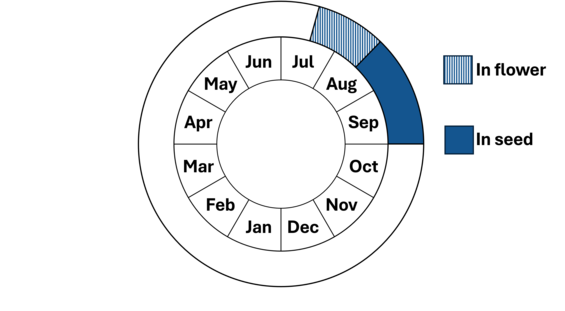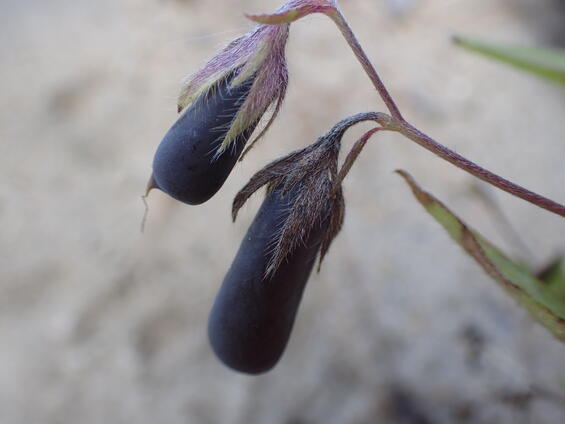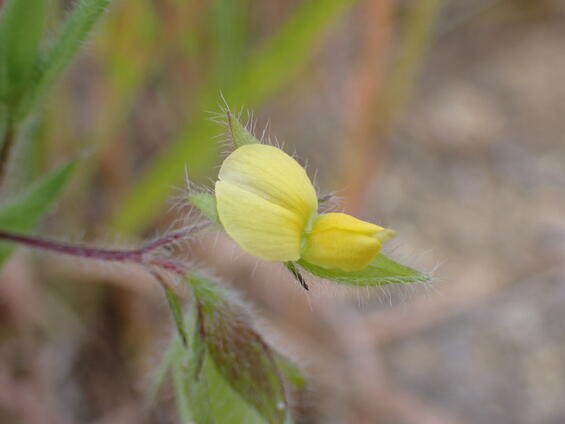- Scientific name: Crotalaria sagittalis L.
- Species of Greatest Conservation Need (MA State Wildlife Action Plan)
Description

Photo credit: Katy Chayka, MinnesotaWildflowers.info
Rattlebox, Crotalaria sagittalis, is an herbaceous annual species in the legume family (Fabaceae) that grows to 30 cm (12 in) in height. The stems, leaves and bracts of flowers are covered with hairs. Its alternate leaves are simple (not divided), elongate ovals tapering to both the tip and base, 3 to 7 cm (1.2 to 2.75 in) long. When fertilized, the legumes (seed pods; 1.5 – 2.7 cm [0.6 – 1 in]) become noticeably inflated and vertically hanging. When the legume is dry, the seeds within produce a rattling sound when shaken.
Life cycle and behavior

Arrowhead rattlebox is an annual, completing its life cycle in one season. Seeds are capable of lying dormant in the seed bank for decades until the proper conditions (contact with mineral soil and exposure to the sun’s warmth) are available. Seeds often sprout in mid-summer, and flowers begin to bloom in late-July. It produces several yellow pea-like flowers, which often bloom asynchronously, so that a plant may have flowers and developing legumes at the same time. Legumes develop in August and are present into September. Arrowhead rattlebox flowers are likely pollinated by mid-sized bees.

Fruits. Photo credit: Chris Buelow

Flower. Photo credit: Chris Buelow
Population status
Arrowhead rattlebox has only recently been listed as a species of greatest conservation need (SGCN) and will be maintained on the plant watch list. As it has not been previously tracked the number of distinct populations and locations is not known. Arrowhead rattlebox is an uncommon and declining habitat specialist in Massachusetts. Arrowhead rattlebox occurs sporadically in open, sandy situations across much of Massachusetts, with the exception of Marthas Vineyard and Nantucket. There have been recent observations in Barnstable, Franklin, Hampden, Hampshire, Middlesex, and Worcester Counties.
Distribution and abundance
Arrowhead rattlebox occurs across most of the eastern United States and the desert southwest and along the Gulf Coast through Central America, as well as South America (POWO 2025). In New England, its northeastern extent, it does not occur in Maine and is possibly extirpated in New Hampshire. In Rhode Island and Vermont, it is critically imperiled as it is in New York. Currently, it is not ranked in Massachusetts or Connecticut. Massachusetts has not compiled sufficient information to determine its status and hopes to obtain additional information on the species locations and populations in the next ten years.
Habitat
Arrowhead rattlebox grows in dry, sandy, open fields and woodlands, including pitch pine/scrub oak barrens and sandplain grasslands. This habitat may include roadsides, gravel and sand pits, waste areas, and railroad lines, among other disturbed areas. Associated species often include little bluestem (Schizachyrium scoparium), scrub oak (Quercus ilicifolia), stiff aster (Ionactis linariifolia), bush clovers (Lespedeza spp.), and goldenrods (Solidago spp.), among other plants common in open areas.
Healthy habitats are vital for supporting native wildlife and plants. Explore habitats and learn about conservation and restoration in Massachusetts.
Threats
The primary threats to arrowhead rattlebox are direct destruction of habitat by all forms of development and succession of open habitats to forests, often because of fire exclusion and lack of management to maintain an area as open land. It is not known how arrowhead rattlebox will be affected by climate change.
Conservation
Survey and monitoring
Surveys for this new SGCN are needed so that it can be assessed, and clear conservation and management activities can be planned. The best time to survey for it is when it is in bloom or in seed from mid-July to mid-September.
Management
The exact ecological needs for arrowhead rattlebox are not known. All active management of rare plant populations (including invasive species removal) is subject to review under the Massachusetts Endangered Species Act and should be planned in close consultation with MassWildlife’s Natural Heritage & Endangered Species Program.
Research needs
As this plant is under-surveyed, more standard information is needed such as lists of associated species, comments on habitat quality and threats, and assessments of soil conditions and phenology. Research is needed to determine whether this plant can be grown in a nursery or garden setting for purposes of reintroductions. If habitat degradation accelerates losses of current populations, this strategy could prove useful to long-term conservation of this species. Research to determine the length of time seeds remain viable under different conditions is needed.
References
Fernald, M. L. 1950. Gray’s Manual of Botany, Eighth (Centennial) Edition—Illustrated. American Book Company, New York.
Gleason, Henry A., and Arthur Cronquist. Manual of Vascular Plants of Northeastern United States and Adjacent Canada, Second Edition. Bronx, NY: The New York Botanical Garden, 1991.
Haines, A. 2011. Flora Novae Angliae – a Manual for the Identification of Native and Naturalized Higher Vascular Plants of New England. New England Wildflower Society, Yale Univ. Press, New Haven, CT.
Native Plant Trust. 2014. NORM Phenology Information.
NatureServe. 2025. NatureServe Network Biodiversity Location Data accessed through NatureServe Explorer [web application]. NatureServe, Arlington, Virginia. Available https://explorer.natureserve.org/. Accessed: 3/27/2025.
POWO (2025). Plants of the World Online. Facilitated by the Royal Botanic Gardens, Kew. Published on the Internet; https://powo.science.kew.org/ Accessed: 3/27/2025.
Contact
| Date published: | April 10, 2025 |
|---|